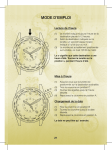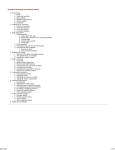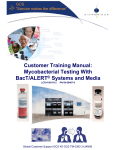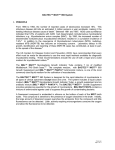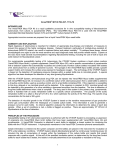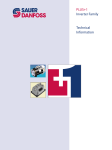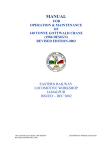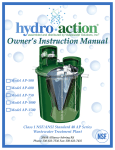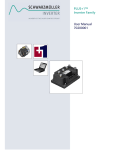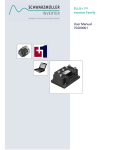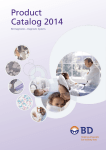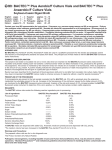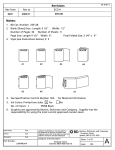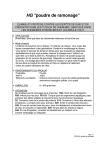Download BACTEC™ MGIT™ 960 PZA Kit
Transcript
BACTEC™ MGIT™ 960 PZA Kit For the Antimycobacterial Susceptibility Testing of Mycobacterium tuberculosis I. INTENDED USE The BACTEC™ MGIT™ 960 PZA Kit is used as a rapid qualitative procedure for susceptibility testing of Mycobacterium tuberculosis, from culture, to pyrazinamide (PZA).The BACTEC MGIT 960 PZA Kit is used with the BACTEC MGIT 960 System. II. SUMMARY AND EXPLANATION Antimycobacterial susceptibility testing is necessary for the proper treatment of patients with tuberculosis. The treatment of tuberculosis is commonly through a multiple drug regimen that includes the antimycobacterial drug pyrazinamide. It is important that the antimycobacterial drug prescribed shows appropriate activity against Mycobacterium tuberculosis, i.e., susceptibility of the isolate to the drug. Multidrug resistant Mycobacterium tuberculosis (MDR-TB) has recently become a serious public health problem.1 Resistance to any of the primary drugs, including pyrazinamide, makes the disease more difficult and expensive to treat. The rapid detection of these resistant isolates is critical to the effective patient management. Two methods have been widely used for antimycobacterial susceptibility testing. The first method, known as the Method of Proportion,2 uses Middlebrook and Cohn 7H10 Agar. It compares colony counts on drug-containing and drug-free media. The testing for pyrazinamide requires some modification from the general methods because the drug is active in vitro only at lower pH values.3 A modification to the method of proportion method was developed using a 7H10 agar medium at pH 5.5, with a drug concentration of 25-50 µg/mL.4 A limitation of the method is that at a pH of 5.5, many isolates of M. tuberculosis either fail to grow or grow poorly. Agar-based methods such as the agar proportion method have not proven to be satisfactory for PZA susceptibility testing because of failure of many isolates to grow when the agar has been acidified for the PZA test. The second method, known as the BACTEC 460TB radiometric susceptibility method,5 is based on the production of radioactive 14C-labeled carbon dioxide by the growing mycobacteria, manifested by a Growth Index increase in the system. A modification to the BACTEC 460TB susceptibility method was developed using a modified 7H12 radiometric medium, BACTEC PZA Test Medium, with a reduced pH of 6.0.6 At this pH, PZA activity against mycobacteria can be determined without inhibiting the growth of most M. tuberculosis isolates. The BACTEC 460TB PZA susceptibility test uses a pyrazinamide drug concentraton of 100 µg/mL. Susceptibility testing in the BACTEC 460TB System has proven to be satisfactory and is presently considered the reference method for PZA susceptibility testing. The National Committee for Clinical Laboratory Standards (NCCLS) recommends the BACTEC 460TB method for PZA susceptibility testing.2 Use of the BACTEC MGIT 960 System in combination with the BACTEC MGIT 960 PZA kit is a non-radiometric method of determining antimycobacterial susceptibility to PZA. The BACTEC MGIT 960 PZA Kit has been developed to allow susceptibility testing at a PZA concentration of 100 µg/mL. This concentration correlates with the concentration used in the BACTEC 460TB System. 1 III. PRINCIPLES OF THE PROCEDURE BACTEC MGIT 960 PZA Medium is a tube containing a modified Middlebrook 7H9 Broth, which supports the growth and detection of mycobacteria at a reduced pH of 5.9. The MGIT 960 PZA Medium tube contains a fluorescent compound embedded in silicone on the bottom of a 16 x 100 mm round-bottom tube. The fluorescent compound is sensitive to the presence of oxygen dissolved in the broth. The initial concentration of dissolved oxygen quenches the emission from the compound, and little fluorescence can be detected. Later, actively growing and respiring microorganisms consume the oxygen, which allows the compound to fluoresce. The BACTEC MGIT 960 PZA Kit is a 4 – 21 day qualitative test. The test is based on growth of the M. tuberculosis isolate in a drug-containing tube compared to a drug-free tube (Growth Control). The BACTEC MGIT 960 instrument continually monitors tubes for increased fluorescence. Analysis of fluorescence in the drug-containing tube compared to the fluorescence of the Growth Control tube is used by the instrument to determine susceptibility results. The BACTEC MGIT 960 instrument automatically interprets these results and reports a susceptible or resistant result. IV. REAGENTS The BACTEC MGIT PZA Medium contains 110 µL of fluorescent indicator and 7 mL of PZA broth. The indicator contains Tris 4, 7-diphenyl-1, 10 phenanthroline ruthenium chloride pentahydrate in a silicone rubber base. The tubes are capped with a polypropylene cap. The pH is adjusted to 5.9. Approximate Formula* Per L of Purified Water: Modified Middlebrook 7H9 broth 5.9 g Casein peptone 1.25 g BACTEC MGIT 960 PZA Kit contains two lyophilized vials of pyrazinamide and six vials of PZA Supplement. Approximate Formula* Per Vial Lyophilized drug: Pyrazinamide 20,000 µg BACTEC MGIT 960 PZA Supplement contains 15 mL of enrichment Approximate Formula* Per L Purified Water: Bovine albumin 50.0 g Catalase 0.03 g Dextrose 20.0 g Oleic Acid 0.1 g Polyoxyethylene stearate (POES) 1.1 g *Adjusted and/or supplemented as required to meet performance criteria. Storage and reconstitution of reagents: BACTEC MGIT 960 PZA Medium - On receipt, store at 2 – 25ºC. DO NOT FREEZE. Broth should appear clear and colorless. Do not use if turbid. Minimize exposure to light. Tubes stored as labeled prior to use, may be inoculated up to the expiration date. 2 BACTEC MGIT 960 PZA Drug vials – On receipt, store the lyophilized drug vials at 2 – 8°C. Once reconstituted, the antibiotic solution may be frozen and stored at -20°C or colder up to six months, not to exceed the original expiration date. Once thawed, use immediately. Discard unused portions. BACTEC MGIT 960 PZA Supplement – On receipt, store in dark at 2 – 8°C. Avoid freezing or overheating. Open and use prior to the expiration date. Minimize exposure to light. Directions For Use: Reconstitute each BACTEC MGIT 960 PZA lyophilized drug vial with 2.5 mL of sterile distilled/deionized water to make a stock solution of 8000 µg/mL. Warnings and Precautions: For in vitro Diagnostic Use. POTENTIALLY INFECTIOUS TEST SPECIMEN: Pathogenic microorganisms, including hepatitis viruses and Human Immunodeficiency Virus, may be present in clinical specimens. “Standard Precautions”7-10 and institutional guidelines should be followed in handling all items contaminated with blood and other body fluids. Working with M. tuberculosis growth in culture requires Biosafety Level (BSL) 3 practices, containment equipment and facilities. Read and follow directions contained in all appropriate package inserts including the BBL™ MGIT™ 7 mL Mycobacteria Growth Indicator Tube. Prior to use, the user should examine the tubes and vials for evidence of contamination or damage. Discard any tubes or vials if they appear unsuitable. Dropped tubes should be examined carefully. If damage is seen, the tube should be discarded. In the event of tube breakage: 1) Close the instrument drawers; 2) Turn off the instrument; 3) Vacate the area immediately; 4) Consult your facility/CDC guidelines. An inoculated, leaking or broken tube may produce an aerosol of mycobacteria; appropriate handling should be observed. Autoclave all inoculated MGIT tubes prior to disposal. V. SPECIMEN PREPARATION All preparations detailed below must be from pure cultures of M. tuberculosis. The laboratory should confirm, by appropriate identification techniques, that the isolate to be tested is a pure culture of M. tuberculosis. 3 Preparation of the Isolate from Solid Media: 1. Add 4 mL of BBL Middlebrook 7H9 Broth (or BBL MGIT broth) to a 16.5 x 128 mm sterile tube with cap containing 8–10 glass beads. 2. Scrape with a sterile loop as many colonies as possible from growth no more than fourteen days old, trying not to remove any solid medium. Suspend the colonies in the Middlebrook 7H9 Broth. 3. Vortex the suspension for 2–3 minutes to break up the larger clumps. The suspension should exceed a 1.0 McFarland standard in turbidity. 4. Let the suspension sit for 20 min without disturbing. 5. Transfer the supernatant fluid to another 16.5 x 128 mm sterile tube with cap (avoid transferring any of the sediment) and let sit for another 15 min. 6. Transfer the supernatant fluid (it should be smooth, free of any clumps) to a third 16.5 x 128 mm sterile tube. NOTE: The organism suspension should be greater than a 0.5 McFarland standard at this step. 7. Adjust the suspension to a 0.5 McFarland standard by visual comparison to a 0.5 McFarland turbidity standard. Do not adjust below a 0.5 McFarland standard. 8. Dilute 1 mL of the adjusted suspension in 4 mL of sterile saline (1:5 dilution). Use this as the AST inoculum and proceed to "Inoculation Procedure for BACTEC MGIT 960 PZA Susceptibility Test." Preparation from a Positive BACTEC MGlT Tube: 1. The first day of an instrument positive BACTEC MGIT tube is considered Day 0. 2. For the preparation of the test inoculum, a positive 7 mL MGIT tube should be used the day after it first becomes positive on the BACTEC MGIT 960 instrument (Day 1), up to and including the fifth day (Day 5) after instrument positivity. A tube which has been positive longer than five days should be subcultured to a fresh 7 mL MGIT tube containing BACTEC MGIT 960 Growth Supplement and tested on the BACTEC MGIT 960 instrument until positive, and used from one to five days following positivity. 3. If the tube is a Day 1 or Day 2 positive, no dilution is required. Use this as the AST inoculum and proceed to "Inoculation Procedure for BACTEC MGIT 960 PZA Susceptibility Test." 4. If the tube is a Day 3, Day 4, or Day 5 positive, then dilute 1 mL of the positive broth in 4 mL of sterile saline (1:5 dilution). Use this as the AST inoculum and proceed to "Inoculation Procedure for BACTEC MGIT 960 PZA Susceptibility Test." VI. PROCEDURE Materials Provided: BACTEC MGIT 960 PZA Kit containing two vials each lyophilized drug and six vials of PZA Supplement (approximately 50 tests per kit). Materials Required But Not Provided: BACTEC MGIT 960 PZA Medium (25 tubes per carton), ancillary culture media, reagents, quality control organisms and laboratory equipment as required for this procedure. 4 Inoculation Procedure for BACTEC MGIT 960 PZA Susceptibility Test: Important considerations when preparing the PZA AST Set are the proper reconstitution of the lyophilized drug, use of pure culture and the proper dilution of the organism for the Growth Control and PZA tube. It is important to add drug only to the corresponding MGIT tube labeled “PZA”. Use only the MGIT 960 PZA supplement supplied with the kit and MGIT 960 PZA Medium tubes when performing the PZA AST set. 1. Label two 7 mL MGlT 960 PZA Medium tubes for each test isolate. Label one as GC (Growth Control), one as PZA. Place the tubes in the correct sequence in the two tube AST set carrier (see BACTEC MGIT 960 User’s Manual, AST Instructions). 2. Aseptically add 0.8 mL of BACTEC MGlT 960 PZA Supplement to each tube. 3. Using a micropipet, aseptically pipet 100 µL of 8000 µg/mL BACTEC MGlT 960 PZA drug solution to the appropriately labeled MGIT PZA tube. No PZA drug solution should be added to the MGlT GC tube. Drug Concentration of Volume Added to Final Concentration MGIT Tubes for in MGIT Tubes Drug after Test Reconstitution* MGIT PZA 8000 µg/mL 100 µL 100 µg/mL* *PZA must be reconstituted using 2.5 mL sterile/deionized water to achieve the concentration indicated. 4. Growth Control tube preparation and inoculation: Aseptically pipet 0.5 mL of the AST inoculum (see “SPECIMEN PREPARATION”) into 4.5 mL of sterile saline to prepare the 1:10 Growth Control suspension. Mix the Growth Control suspension thoroughly. Inoculate 0.5 mL of the 1:10 Growth Control suspension into the MGIT tube labeled “GC.” NOTE: It is important to use an appropriately prepared 1:10 dilution for the “GC” tube to ensure accurate AST results and avoid PZA AST set errors. 5. Drug-containing tube inoculation: Aseptically pipet 0.5 mL of the AST inoculum (see “SPECIMEN PREPARATION”) into the MGIT tube labeled “PZA”. 6. Tightly recap the tubes. Mix tubes thoroughly by gentle inversion three to four times. 7. Enter the PZA set into the BACTEC MGIT 960 instrument using the AST set entry feature (refer to the BACTEC MGIT 960 User’s Manual, AST Instructions). Ensure that the Growth Control tube is in the first left tube position. Select PZA as the drug in the 2 tube AST set carrier definition when performing the AST set entry. 8. Streak 0.1 mL of the organism suspension to a Trypticase™ Soy Agar with 5% Sheep Blood (TSA II) plate. Enclose in a plastic bag. Incubate at 35 – 37°C. 9. Check the blood agar plate at 48 h for bacterial contamination. If the blood agar plate shows no growth, then allow PZA testing to proceed. If the blood agar plate shows growth, discard the PZA set (refer to the BACTEC MGIT 960 User’s Manual, AST Instructions) and repeat testing with a pure culture of Mycobacterium tuberculosis. 5 VII USER QUALITY CONTROL Upon receipt of a new shipment or lot number of BACTEC MGIT 960 PZA Kit vials or BACTEC MGIT PZA Medium, it is recommended that the control organism shown below be tested. The control organism should be a pure culture and the culture should be prepared according to "SPECIMEN PREPARATION" instructions. The quality control (QC) AST Set should be prepared according to the “Inoculation Procedure for BACTEC MGIT 960 PZA Susceptiblity Test” instructions. Important considerations when preparing the QC AST Set are the proper reconstitution of the lyophilized drug, use of pure culture and the proper dilution of the QC organism for the Growth Control and PZA tubes. It is important to add drug only to the corresponding MGIT tube labeled “PZA”. The same control organism should be run as batch QC once each week when susceptibility testing is performed. Observation of the proper results, as shown below, within 4 - 20 days indicates that the BACTEC MGIT 960 PZA reagents are ready for use in testing patient isolates. If the proper results are not observed, do not report patient results. Repeat QC and any patient isolates affected by the initial QC failure. If the repeat QC does not perform as expected, do not report patient results. Do not use the product until you have contacted Technical Services at (800) 638-8663 (United States Only). Strain GC MGIT PZA M. tuberculosis Positive Susceptible ATCC™ 27294 During the external evaluation of the BACTEC MGIT 960 PZA Kit the average time to result for the control organism was seven days with a range of four to eleven days. The most common causes of QC failures during the external evaluation were over-inoculated PZA Sets and contaminated QC cultures. VIII. RESULTS The BACTEC MGIT 960 instrument will monitor AST sets until a susceptible or resistant determination is made. Once the set testing is completed, the results are reported by the BACTEC MGIT 960 instrument (refer to the BACTEC MGIT 960 User’s Manual, AST Instructions). The BACTEC MGIT 960 instrument will report an AST Set result as an Error (“X”), no susceptibility interpretation, when certain conditions occur that may affect the test results. Conditions that may result in an Error (“X”) result are described in the AST Instructions, Section 6 – Troubleshooting of the BACTEC MGIT 960 User’s Manual. It is important to include the test method, drug name and concentration when reporting results. The Pulmonary and/or Infectious Disease specialist in TB control should be consulted concerning the appropriate therapeutic regimen and dosages. 6 Mono-resistance to pyrazinamide is uncommon, therefore in the event of unexpected resistant results, verify purity and identification of the isolate tested as M. tuberculosis. Guidelines for mycobacterial purity checks can be found in the NCCLS M24 standard.2 BACTEC MGIT 960 PZA result reporting Drug (concentration) MGIT 960 result Resistant Recommended Report Isolate tested with BACTEC MGIT 960 [PZA/100 µg/mL] and result is susceptible. Isolate tested with BACTEC MGIT 960 [PZA/100 µg/mL] and result is resistant. Error “X” No report. Susceptible PZA (100 µg/mL) IX. Action No action. If isolate is monoresistant to PZA, confirm that isolate tested is a pure culture of Mycobacterium tuberculosis. Repeat test. LIMITATIONS OF THE PROCEDURE The BACTEC MGIT 960 PZA susceptibility test does not interpret the degree of susceptibility of the isolate being tested. Results are reported as either susceptible or resistant. The BACTEC MGIT 960 PZA susceptibility test can only be performed using the BACTEC MGIT 960 instrument. The PZA Sets cannot be read manually. Use only pure cultures of M. tuberculosis. Cultures that are contaminated or that may contain multiple species of mycobacteria may give erroneous results and should not be tested. Direct testing from clinical specimens is not recommended. Suspensions made from solid media must be allowed to settle for the prescribed times prior to standardization. Inoculum preparations made from solid media should be visually compared to a 0.5 McFarland turbidity standard; failure to do so may give inaccurate results or cause an AST Set error. Failure to use the 1:5 dilution of the organism suspension, when indicated, to inoculate the drug containing tubes may give inaccurate results. Failure to use a 1:10 dilution of the organism suspension for the inoculation of the Growth Control tube may give inaccurate results or cause an AST Set error. Failure to reconstitute the PZA drug with the appropriate volume of sterile distilled / deionized water may give inaccurate results. Thorough mixing of inoculated tubes is important. Failure to mix the tubes adequately may lead to false resistant results. 7 Failure to load the tubes of the AST Set into the AST Set Carrier in the proper sequence may give inaccurate results. Failure to select the appropriate set carrier drug definition may result in invalid or inaccurate results. Failure to load the AST Set into the instrument correctly will result in an anonymous condition that must be resolved within eight hours. If condition is not resolved within eight hours, the AST Set must be discarded and set up again. Failure to use the BACTEC MGIT 960 PZA Supplement in the PZA AST set may give inaccurate results. DO NOT add BACTEC MGIT 960 SIRE Supplement or BACTEC MGIT 960 Growth Supplement to the PZA AST set. Failure to use BACTEC MGIT PZA Medium for the PZA AST set may give inaccurate results. DO NOT substitute BBL MGIT 7 mL Mycobacteria Growth Indicator Tubes for BACTEC MGIT PZA Medium. X. EXPECTED VALUES A total of 118 clinical isolates of M. tuberculosis were tested with the BACTEC MGIT 960 PZA susceptibility test at four geographically diverse sites. The testing included both fresh clinical and subcultured isolates from both liquid and solid culture sources. A total of 228 PZA susceptibility tests (liquid and solid) were performed. During the external evaluation of the BACTEC MGIT 960 PZA Kit, there were nine PZA tests from clinical trial isolates that required repeat testing due to contamination (six isolates) or overinoculation/procedural errors (three isolates). The average time-to-result for the BACTEC MGIT 960 PZA susceptibility test is seven days with a range from four to seventeen days. The data are shown in Figure 1. 8 Figure 1: Distribution of BACTEC MGIT 960 PZA AST Time to Result Frequency Distribution of PZA Time in Protocol (TIP) 90.0% Number Interpreted by TIP 50 80.0% 70.0% 40 60.0% 50.0% 30 40.0% 20 30.0% 20.0% 10 10.0% 0 Number of PZA Sets Interpreted by TIP Cumulative % Interpreted 4 5 6 8 9 10 11 12 14 15 16 17 18 19 21 >21 1 30 55 40 19 12 5 6 2 0 1 1 0 0 0 .0% 0 .4% 13.537.679.087.392.694.897.4 99.199.199.6100.100.100.100.100. TIP in Days XI. PERFORMANCE CHARACTERISTICS Analytical Studies Liquid and Solid Media AST Inoculum Ranges: Liquid media - The recommended procedure for preparing a PZA Set from a positive MGIT 7 mL tube uses a direct inoculum on Day 1 and Day 2 post-positivity and a dilute (1:5) inoculum on Day 3 to Day 5 post-positivity. Internal studies show that inocula prepared from a Day 1 to Day 5 positive MGIT 7 mL tube range between 2.0 x 104 to 7.5 x 106 CFU/mL. Solid media - The recommended procedure for preparing a PZA Set from growth on solid media (up to 14 days after first visible growth is seen) uses a 1:5 dilution of an organism suspension equivalent to a 0.5 McFarland Standard. Internal studies show that inocula prepared from solid medium culture range between 2.1 x 105 to 3.9 x 106 CFU/mL. 9 Cumulative % Interpreted by TIP 100.0% 60 Lot Reproducibility: Lot reproducibility was evaluated using twenty-five M. tuberculosis strains (including three ATCC™ strains). Each strain was tested in triplicate with the BACTEC MGIT 960 PZA susceptibility test. Each replicate represented a separate test condition differentiated by lot of PZA drug, PZA Supplement and PZA medium used (three lots each). Observed results were compared to the expected results. The overall reproducibility for the BACTEC MGIT 960 PZA susceptibility test is 96.8%. CDC Challenge Panel Testing: The performance of the BACTEC MGIT 960 PZA susceptibility test was evaluated using a panel of challenge strains obtained from the Centers for Disease Control and Prevention (CDC), Atlanta, GA, USA. The panel consisted of nine strains of M. tuberculosis with known susceptibility patterns (using BACTEC 460TB). The panel was tested in triplicate with the BACTEC MGIT 960 PZA susceptibility test. The BACTEC MGIT 960 PZA results were compared to the CDC expected results. The overall agreement with CDC expected results for the BACTEC MGIT 960 PZA test is 98.7%. Clinical Evaluation The BACTEC MGIT 960 PZA susceptibility test was evaluated at four geographically diverse clinical sites composed of regional reference centers and university hospital-based laboratories, including two ex-US sites. The BACTEC MGIT 960 PZA susceptibility test was compared to the BACTEC 460TB PZA susceptibility test method. Reproducibility Testing: The reproducibility of the BACTEC MGIT 960 PZA susceptibility test was evaluated at the clinical sites using a panel of five qualified strains. The BACTEC MGIT 960 PZA test results were compared to the expected results. The overall reproducibility for the BACTEC MGIT 960 PZA susceptibility test is 94%. CDC Challenge Panel Testing: The performance of the BACTEC MGIT 960 PZA susceptibility test was evaluated at each of the four clinical sites using a panel of challenge strains obtained from the Centers for Disease Control and Prevention (CDC), Atlanta, GA, USA. The panel consisted of nine strains of M. tuberculosis with known susceptibility patterns (using BACTEC 460TB). Of the thirty-six PZA results collected with the BACTEC MGIT 960 PZA susceptibility test, thirty-three agreed with the CDC expected results. The calculated percent agreement to the CDC expected results for the BACTEC MGIT 960 PZA susceptibility test is 91.7%. Clinical Isolate Testing: 10 A total of 118 clinical isolates of M. tuberculosis were tested with the BACTEC MGIT 960 PZA susceptibility test and the BACTEC 460TB PZA susceptibility test. This included testing of both fresh clinical and subcultured isolates from both liquid and solid culture sources. This generated a total of 228 test results. Table 1 presents the results from clinical isolate testing for PZA drug at 100 µg/mL from liquid source cultures, from solid source cultures and both source cultures combined. Table 1: Clinical Isolate Results – BACTEC MGIT 960 PZA test Compared to BACTEC 460TB test BACTEC 460TB System Expected PZA Results BACTEC MGIT 960 System Susceptible Results Resistant Results Category Category # # agreement % agreement % agree agree (95% CI) (95% CI) Source # Tests S R LIQUID 112 89 23 88 SOLID 113* 90 23 88 ALL 225* 179 46 176 98.9% (93.9-100) 97.8% (92.2-99.7) 98.3% (95.2-99.7) 22 20 42 95.7% (78.1-99.9) 87.0% (66.4-97.2) 91.3% (79.2-97.6) *Three BACTEC 460TB borderline results are not included in this table. All isolates with discordant BACTEC MGIT 960 PZA results were tested using the BACTEC 460TB PZA susceptibility test at two independent sites. Discordant results were those strains where the BACTEC MGIT 960 PZA result differed from the BACTEC 460TB PZA result. Borderline results are not included in the performance calculations for the BACTEC MGIT 960 PZA Kit. Of the four discordant PZA susceptible (S-MGIT 960, R-BACTEC 460TB) isolates tested, one had susceptible results from both independent sites and the other three had resistant results from both independent sites. Of the three discordant PZA resistant (R-MGIT 960, S-BACTEC 460TB) isolates tested, all isolates had susceptible results from both independent sites. Two of the three BACTEC 460TB borderline PZA results (S-MGIT 960, B-BACTEC 460TB) had susceptible results from both independent sites. One of the three BACTEC 460TB borderline PZA results (R-MGIT 960, B-BACTEC 460TB) had one independent site determine a susceptible result. The other independent site determined a borderline result. XII. AVAILABILITY Cat. No. Description 245128 BACTEC™ MGIT™ 960 PZA Kit, carton of 2 lyophilized drug vials and 6 PZA Supplements. 245115 BACTEC™ MGIT™ PZA Medium, carton of 25 tubes. 11 XIII. REFERENCES 1. Barenfanger, J. 1993. Making your lab safe against multi-drug resistant Mycobacterium tuberculosis. Clin. Microbiol. Newsl. 15: 76-80. 2. National Committee for Clinical Laboratory Standards. 2001. Approved standard: M24-A. Susceptibility testing of mycobacteria, Nocardia, and other aerobic actinomycetes . NCCLS, Wayne, Pa. 3. Butler, W.R. and Kilburn. 1982. Improved method for testing susceptibility of Mycobacterium tuberculosis to pyrazinamide. J.Clin.Microbiol. 16:1106-1109. 4. Heifets, L.B. and Iseman, M.D. 1985. Radiometric method for testing susceptibility of Mycobacterium tuberculosis to pyrazinamide in 7H12 broth. J.Clin.Microbiol. 21:200-204. 5. BD Diagnostic Systems. BACTEC™ 460TB System Product and Procedure Manual. 6. Salfinger, M. et al. 1989. Rapid radiometric method for pyrazinamide susceptibility testing of Mycobacterium tuberculosis. Res. Microbiol 1989. 140:301-309. 7. National Committee for Clinical Laboratory Standards. 2002. Approved Guideline M29-A2. Protection of laboratory workers from occupationally acquired infections. NCCLS, Wayne, Pa. 8. Garner, J.S. 1996. Hospital Infection Control Practices Advisory Committee, U.S. Department of Health and Human Services, Centers for Disease Control and Prevention. Guideline for isolation precautions in hospitals. Infect. Control Hospital Epidemiol. 17:5380. 9. U.S. Department of Health and Human Services. 1999. Biosafety in microbiological and biomedical laboratories, HHS Publication (CDC) 4th ed. U.S. Government Printing Office, Washington, D.C. 10. Directive 2000/54/EC of the European Parliament and of the Council of 18 September 2000 on the protection of workers from risks related to exposure to biological agents at work (seventh individual directive within the meaning of Article 16(1) of Directive 89/391/EEC). Official Journal L262, 17/10/2000, p. 0021-0045. XIV. TECHNICAL INFORMATION In the United States, telephone Technical Services, toll free (800) 638-8663. Approved by: Supervisor:_____________________________ Date:____________ Director:_______________________________ Date:____________ Effective Date:_________________ Reviewed by Date: PI Rev 07/02 Rev 07/02 12












